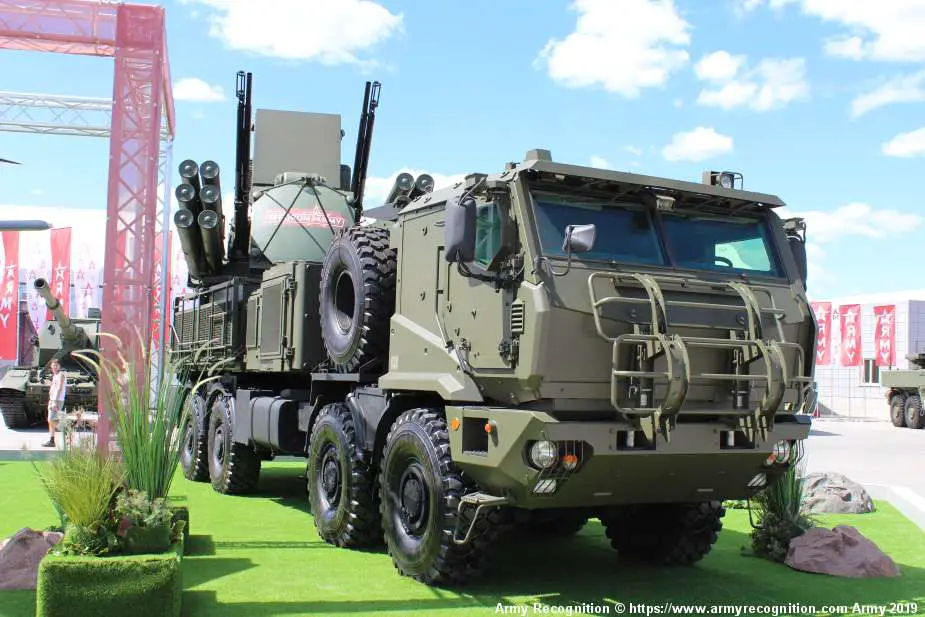- Army
- Conflicts in the world
- Israel - Iran conflict 2025
- Pakistan - India Conflict 2025
- Russia Ukraine War 2022
- Libya conflict day by day
- HAMAS - Israel War 2023
- Operation Serval in Mali French Army
- Sangaris operation Central African Republic
- Sangaris opération militaire République Centreafrique
- Ukraine - Russia conflict
- Syria conflict news
- Defence & Security Industry Technology
- Armies in the world
- Analysis Defense and Security Industry
- Conflicts in the world
- Navy
- Air
Russia reportedly deploys in Ukraine upgraded Pantsir-SM new air defense systems
According to several Russian sources on December 21, 2023, an unknown number of Pantsir-SM air defense missile systems are said to be operational in the combat zone in Ukraine. This vehicle is an improved iteration of the existing Pantsir-S1, featuring enhancements such as a new high-speed missile and an increased target detection and destruction range, which allows it to effectively engage smaller targets like drones.
Follow Army Recognition on Google News at this link

The Pantsir-SM air defense system was showcased at the Army-2019 exhibition in Moscow, Russia. (Picture source: Army Recognition)
The deployment of an advanced air defense system like the Pantsir-SM in a conflict such as the one in Ukraine could offer several potential advantages compared to its predecessor, the Pantsir-S1. These advantages are based on the improved features and capabilities of the Pantsir-SM.
The Pantsir-S1 and its upgraded version, the Pantsir-SM, are both Russian air defense systems with distinct improvements. These enhancements primarily focus on expanding the system's capability against a wider range of targets and enhancing its performance in various operational scenarios.
An important upgrade in the Pantsir-SM is the extension of its detection and engagement ranges. This version incorporates advanced radar and missile technologies that enable it to detect targets up to 75 kilometers away and engage them at distances of up to 40 kilometers. This represents a significant increase compared to the detection and engagement capabilities of the Pantsir-S1, which has shorter ranges.
Additionally, the Pantsir-SM is equipped with new missiles designed to offer improved speed, range, and precision. These missiles are intended to effectively counter a broader spectrum of aerial threats, including low-flying drones, precision-guided munitions, as well as more traditional air attack weapons such as aircraft and helicopters.
Moreover, the Pantsir-SM incorporates advanced radar and targeting systems that provide enhanced tracking accuracy and the capability to engage multiple targets simultaneously. This enhancement is particularly crucial in high-threat environments where the system may encounter a barrage of incoming threats from various directions.
The Pantsir-SM's mobility and deployment efficiency have also seen improvements, ensuring quicker reaction times and adaptability in diverse terrain types. These enhancements make the system more versatile and effective in rapidly changing combat situations.

Equipped with a multi-functional targeting radar station, the Pantsir-SM extends its target detection range to approximately 75 km. (Picture source: Army Recognition)
The Pantsir-SM, designed exclusively for the Russian Armed Forces, is a mobile short-range air defense missile system built on the KamAZ K-53958 'Tornado' 8×8 military truck chassis. It features an armored crew cab to provide protection against small arms fire and artillery shell splinters. The weapon station is situated at the rear of the truck and includes two-barreled 2A38M 30mm automatic cannons, along with 12 launchers for surface-to-air missiles. Additionally, there are six missile containers mounted on each side of the turret.
Equipped with a multi-functional targeting radar station, the Pantsir-SM extends its target detection range to approximately 75 km, with a sighting range of up to 40 km and an altitude reach of 15 km. This system is capable of engaging various aerial targets with speeds of up to 2,000 m per second, including fighter jets, helicopters, unmanned aerial systems (UAS), guided projectiles, and missiles. Moreover, the system can be deployed in just five minutes, featuring a reaction time of five seconds and achieving a top speed of 100 km/h. It is operated by a crew of three and has an operational range of up to 1,000 km.
The Pantsir-SM is equipped with an infrared electro-optical target tracking system to enhance tracking capabilities, particularly at shorter ranges. This enables it to effectively counter smaller targets such as makeshift drones, quadcopters, and mortar mines. The system's capability in this regard is facilitated by the inclusion of eight miniaturized surface-to-air guided missiles specifically designed for these threats. These mini-missiles can be arranged in packs of four within a standard launch container, potentially increasing the total missile count to either 48 or 96, depending on the system's configuration.
In terms of armament, the Pantsir-SM is equipped with ten surface-to-air guided missiles for long-range engagements. It can launch the new 57E6M-E high-speed two-stage missile, which has a maximum firing range of 30 kilometers. Alternatively, it can employ the 57E6-E missile, offering a range of 15 to 18 kilometers. For short-range aerial targets, the system could either use mini-missiles or two 2A38M 30mm automatic cannons. These cannons are also found on other air defense systems, including the 2S6M Tunguska-M, Pantsir-S1, and Pantsir-S2, as well as surface-to-air missile (SAM) systems.
The 2A38M cannons are equipped with water cooling and have been designed for reliable operation in various environmental conditions, spanning from -50 to +50°C. Their effective range against aerial targets extends from 200 to 2,000 m, with a maximum altitude reach of 4,000 m.
Moreover, there will be two versions of the new Pantsir-SM, one with a radar and another without it, but with an increased missile load of 24 per installation. As with other variants of the Pantsir system, various bases will be available, including tracked, sea, and armored personnel carriers.
Finally, in addition to its capabilities, the Pantsir-SM offers the potential for network-centric warfare. Multiple systems can be integrated into a local network, enabling enhanced coordination and target distribution. This functionality allows a battery of Pantsir-SM vehicles to function as a unified defense system, guided by a central command post.


























